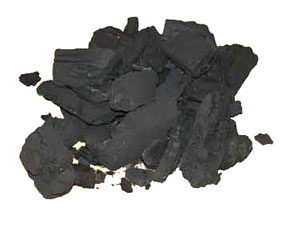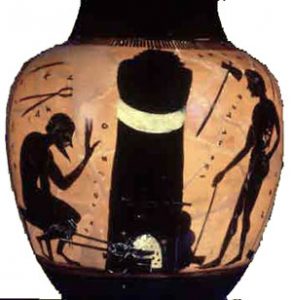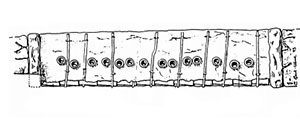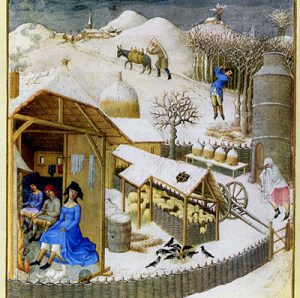
History of fire: San men around a campfire
The first campfires
Probably people were all still in Africa when they first began to use fire for cooking, about 800,000 or a million years ago. People had always known about fire, because fires happened naturally when there were lightning strikes or sparks from two rocks hitting together. Probably the first people who made their own fires started them from fires that were already going. Then, because fire was so useful, they experimented until they figured out how to make fires themselves by hitting flints together or by rubbing two sticks together. It’s not just modern humans who learned to use fire: Neanderthals and other early humans also built fires.
Cooking food
Fire was a very early invention, only a little after simple tools like stone choppers, and before clothing. Making their own fires let people cook their food. Cooked food is easier to digest than raw food, and people can get more energy from it with less work. This extra energy may have been what helped people grow bigger brains than monkeys, and get smarter so they could invent other things.

Charcoal
Building community
At the same time, once people needed fires to cook their food, they couldn’t just go off alone into the forest – they needed to all sit together around their fire. In the Stone Age, it was too hard to make your own fire. This encouraged people to learn to get along with each other and cooperate instead of fighting, and helped to form organized tribes.

Black-figure vase showing a blacksmith at work (Athens, about 550 BC)
Hearths, ovens, and kilns
But by the Late Stone Age, around 6000 BC, people were beginning to live in houses, and the houses were in small villages. They wanted a fire in each house. So they needed to be more careful with their wood supply, to make it last. They started to use ovens. Also, they began to make fired pottery around this time, which needs very hot and long fires in a kiln (a sort of oven).
Charcoal fires
By 4000 BC people started to cook on charcoal fires, instead of just using wood. You make charcoal by slowly burning wood in a kiln with very little air- this half-burned wood is charcoal. It burns more efficiently and hotter than wood (You use charcoal today in backyard barbecues).

Steel furnace from Samanalawewa, Sri Lanka, 300s BC
Smelting bronze
Around 3000 BC, people in West Asia began to use charcoal to smelt copper and tin together into bronze. You need a hot charcoal fire to smelt metal – wood fires don’t burn hot enough.
Smelting iron and making steel
Blacksmiths needed even hotter fires to smelt iron. The method was not invented until about 1500 BC, by the Hittites in West Asia, and then it spread to the rest of Asia and to Europe from there. By about 300 BC, Indian and Sri Lankan blacksmiths were using more complicated, wind-fed forges to make crucible steel. African blacksmiths may have invented iron smelting for themselves, about 300 AD.

February, in the Tres Riches Heures du Duc de Berry (1400s AD) (see the chimney?)
Fire in the Roman Empire
The Romans, beginning around 200 BC during the Roman Republic, used charcoal fires to heat air and water and piped it through their houses to heat their houses and to get hot water for public and private bath buildings. But most people used small charcoal fires in clay braziers to heat their houses and to cook on at home.
Chimneys: the Middle Ages
In the Middle Ages in Europe, these pipes went out of use, and people went back to wood or charcoal fires on hearths in their houses. They did start to use chimneys to get the smoke out of their houses. At the same time, in the Islamic Empire in West Asia and North Africa, people kept on using hot water pipes to heat rich people’s houses and public baths, and clay braziers for small fires.
The dangers of fires
Fire was useful for all kinds of things in the ancient and medieval world, but it was also very dangerous. Because people built their houses of wood, and had thatched roofs, and then built fires inside their houses to cook on and to heat their houses, it was very common for their houses to catch fire and burn down.
Fire safety codes and regulations
And, because villages had lots of these wooden houses close together, often when one house caught fire, the whole village would burn. In the ancient world, they didn’t have fire departments, so there was nobody to put out a fire once it got started. The Romans tried to make some rules about how close together houses could be, and they made a law that every building had to have buckets of water standing around in case of fire, but a lot of people probably didn’t follow these rules. Even if they did, a few buckets of water wouldn’t be enough to stop a house fire. Pliny the Younger tried to start a fire department, but the Roman emperor Trajan said he couldn’t, because an organized fire department might start a rebellion against Rome.
And so the world did have many very serious fires. One example of a very serious fire is the Great Fire of Rome in 66 AD. There was also a very bad fire in 1666 in London, the Great Fire of London.
Did you find out what you wanted to know about the history of fire? Let us know in the comments!
Learn by doing: make a campfire and cook dinner on it
Invention of chimneys
Bibliography and further reading about fire: